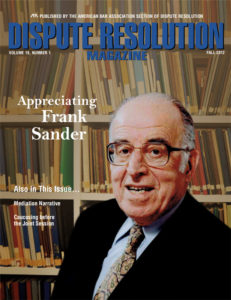Leading the Alternative Dispute Resolution (ADR) field
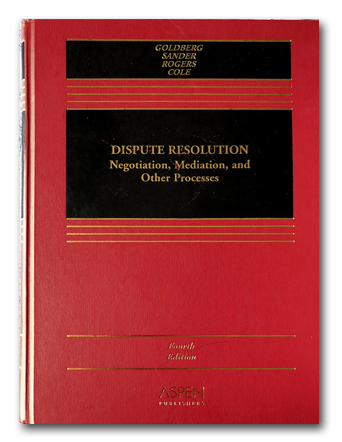
During the last 30 years of his life Frank was known as the father and eventually as the grandfather of Alternative Dispute Resolution (ADR). Frank’s interest in the ADR field developed out of a sabbatical reflection in Sweden. In 1975 Frank was studying the legal rights of co-habiting (e.g. non-married couples). While sitting at the University of Stockholm, he was struck by the contrast between his labor arbitration experience where disputes were resolved quickly and inexpensively outside the courts versus family law divorce disputes in the U.S. where the involvement of lawyers and courts cost families huge sums, often made the situation more adversarial, and didn’t necessarily produce more stable life for the children.
Frank put thoughts (what he called “musings”) to paper contrasting the worlds of mediation and family justice centers used more in China or Sweden with litigation and traditional court adjudication used in the U.S. and sent his memo back home to some of his HLS colleagues. One of these colleagues was Bob Keeton, who forwarded Frank’s memo to Professor Leo Levin who was working with U.S. Chief Justice Warren Burger to put on the Pound Conference the following Spring 1976 in Minnesota on dissatisfaction with the administration of justice. The Pound Conference (named in honor of former HLS Dean Roscoe Pound) was sponsored by the ABA, the Judicial conference of the U.S. and the State Conference of Chief Justices.
As Frank later explained:
“I was sitting around writing Christmas cards in December 1975 when I received a telegram from Chief Justice Warren Burger asking if I would be willing to come down and talk to him about giving a paper at the Pound Conference… next April on dispute settlement. I was totally unqualified to do it as a scholar but I went there and had a very interesting discussion with Burger and the net result was that I crash-educated myself and gave a paper called ‘Varieties of Dispute Processing’ at the Conference with over 200 judges, scholars and bar leaders in attendance. In the paper I went through different dispute processes and explored what they were best suited for and at the end came out with the notion of the multi-door courthouse (i.e., a courthouse where disputes would be screened at entry and referred to different processes or doors for their resolution).”
According to Frank:
“It was a classic example of being in the right place at the right time. One of the people who commented on my paper was Griffin Bell who was a federal judge and became Attorney General of the U.S. under President Carter. Griffin Bell set up a division of the Department of Justice called the Office for Improvements in the Administration of Justice.”
Over time Frank had a vision for how disputes could be more fairly resolved. He was struck by the long waiting time for many court cases and the hardship that this imposed on families with lesser means. Frank had a vision for how to rethink the way that people settle disputes and how to “fit the forum to the fuss.” Frank’s thinking has had impact not only in this country (with increase in mediation and arbitration and rise of neighborhood justice centers) but across the world.
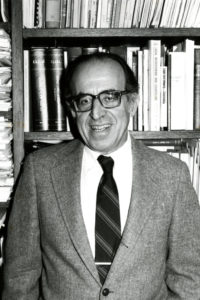
Frank went on to develop a course in Alternative Dispute Resolution at HLS, to chair a special committee set up by the ABA on Alternative Dispute Resolution, and to author many scholarly publications. In 1977 Frank was asked to serve as special consultant to the ABA to assist it in putting on the Conference on the Resolution of Minor Disputes at Columbia Law School. In 1979 Frank co-founded the Program on Negotiation at Harvard Law School with other colleagues.
From 1980 to 2005 Frank taught a course in Mediation/ADR for practicing lawyers under the Program of Instruction for Lawyers. Today approximately half of the lawyers coming each year to HLS for continuing education take the Mediation/ADR course. In 1982 Frank ran a workshop at HLS for law professors interested in dispute settlement and published the results in June 1984 in the Journal of Legal Education. In 1984 “The Role of Courts in American Society” was published by the Council on the Role of Courts. In 1987 Frank founded the Senior Mediators Group to give practitioners a place to compare notes and to learn from each other. In 1991 Frank organized a conference at HLS on “Emerging ADR Issues in State and Federal Courts” and edited a volume growing out of that conference which was published by the ABA Litigation Section. In 2006 Frank helped to found the Clinical Mediation Program at HLS.
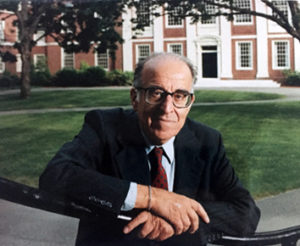 Frank saw the need for writing and text books in the emerging ADR field, developing curricula for current students as well as offering conferences to retrain professionals. In 1979, with Frederick Snyder, he published through the ABA an extensive bibliography on dispute resolution. In 1984 Frank put on a conference on “the Lawyer’s Changing Role in Dispute Settlement.” In 1985, with Professors Eric Green and Stephen Goldberg, Frank co-authored “Dispute Resolution” which was published by Little Brown and which won the Center for Public Resources award for outstanding dispute resolution book that year. Goldberg, noted that the three co-authors spent many hours over a month around Sander’s Cambridge dining room table trying to organize and structure a field of study, create some of the problems for the textbook, and draw upon many neighboring fields since the field was so embryonic, with Sander relentlessly encouraging them on. A new edition of the book was published in 1992 co-authored by Sander, Goldberg and Rogers and is now in its 4th edition and used in law schools throughout the U.S. In 1987 Frank wrote “Alternative Dispute Resolution: An ADR Primer.” In 1992 Frank co-authored “Dispute Resolution: Negotiation, Mediation, and Other Processes” with Nancy Rogers and Stephen Goldberg. He collaborated on the 2014 Designing Systems and Processes for Managing Disputes – with Nancy Rogers, Bob Bordone, and Craig McEwen. Frank served as the founding Chair of the editorial board for the Dispute Resolution magazine of the ABA Dispute Resolution section from 1994-2012, before becoming Chair emeritus.
Frank saw the need for writing and text books in the emerging ADR field, developing curricula for current students as well as offering conferences to retrain professionals. In 1979, with Frederick Snyder, he published through the ABA an extensive bibliography on dispute resolution. In 1984 Frank put on a conference on “the Lawyer’s Changing Role in Dispute Settlement.” In 1985, with Professors Eric Green and Stephen Goldberg, Frank co-authored “Dispute Resolution” which was published by Little Brown and which won the Center for Public Resources award for outstanding dispute resolution book that year. Goldberg, noted that the three co-authors spent many hours over a month around Sander’s Cambridge dining room table trying to organize and structure a field of study, create some of the problems for the textbook, and draw upon many neighboring fields since the field was so embryonic, with Sander relentlessly encouraging them on. A new edition of the book was published in 1992 co-authored by Sander, Goldberg and Rogers and is now in its 4th edition and used in law schools throughout the U.S. In 1987 Frank wrote “Alternative Dispute Resolution: An ADR Primer.” In 1992 Frank co-authored “Dispute Resolution: Negotiation, Mediation, and Other Processes” with Nancy Rogers and Stephen Goldberg. He collaborated on the 2014 Designing Systems and Processes for Managing Disputes – with Nancy Rogers, Bob Bordone, and Craig McEwen. Frank served as the founding Chair of the editorial board for the Dispute Resolution magazine of the ABA Dispute Resolution section from 1994-2012, before becoming Chair emeritus.
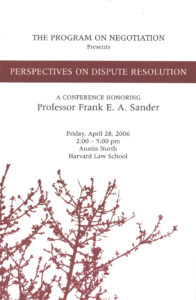
Frank’s leadership in the ADR field received significant recognition. In 1988 Frank was awarded the Whitney North Seymour Medal by the ABA for distinguished service to arbitration and other forms of dispute resolution. In 1989 the ABA established the Frank E.A. Sander Lecture series on dispute resolution for an annual presentation by a leading scholar or practitioner. In 1990 the Center for Public Resources gave Frank a special award for distinguished contributions to the alternative dispute resolution field. In 1999, Frank received the D’Alemberte-Raven medal for outstanding contributions to the field of dispute resolution. In 2006 Frank was awarded the Lifetime Achievement Award by the International Academy of Mediators. In April 2006 the Program on Negotiation at HLS held a conference honoring Frank Sander for his leadership in the field. (For a full list of all awards Frank received click here)
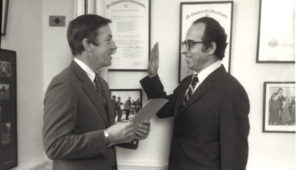
As the ADR field grew, Frank was asked to play additional roles. In 1990 Frank was named to the Commission on the Future of Mass Courts by Paul Liacos Chief Justice of the Supreme Judicial Court of Massachusetts. Frank’s role was to serve as co-chair of the Commission’s Task Force on Alternative Paths to Justice. In 1990 Frank was invited with Emily to be a resident scholar at the Rockefeller Study Center in Bellagio Italy. From 1994-2002 Frank served as Vice-chair of the Standing Committee on Dispute Resolution appointed by the Mass Supreme Judicial Court as well as a member of the drafting committee of the Conference of Commissioners on Uniform State Law’s project to develop a Uniform Mediation Act, which led to SJC Rule 1:18 the Uniform Rule on Dispute Resolution.
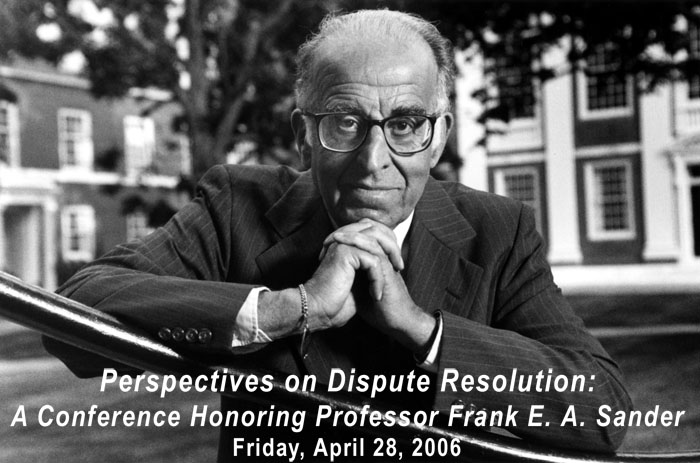 Frank spent much time training and exchanging views on ADR with lawyers from around the world. In 1989 Frank was invited by the Law Council of Australia to give a talk on U.S. dispute resolution at the 26th Australian Legal Convention in Sydney. In that same year he was invited to speak on “Institutionalizing ADR: The Newest Challenge” Edward Donley Memorial Lectures at the West Virginia University College of Law.
Frank spent much time training and exchanging views on ADR with lawyers from around the world. In 1989 Frank was invited by the Law Council of Australia to give a talk on U.S. dispute resolution at the 26th Australian Legal Convention in Sydney. In that same year he was invited to speak on “Institutionalizing ADR: The Newest Challenge” Edward Donley Memorial Lectures at the West Virginia University College of Law.
Today Multi-door courthouses and their equivalents are deployed in more than 7 States and various forms of ADR have come to exist in 25 other states/cities as well as a number of other countries including Singapore and Nigeria.
Click to read ABA Dispute Resolution Magazine Fall 2012 Tribute to Frank
Frank’s views on the state of ADR ~ 2014
Concerns and Optimism for the Future Clip
The Three Phases of Alternative Dispute Resolution
Developing this field was a passion for Frank and his support consisted of building scholarship and curricula at many law schools, developing networks for practitioners, and helping many budding lawyers who decided they wanted to enter this emerging field. At Frank’s Harvard retirement dinner in 2006 with over 200 participants, they asked everyone to stand up who had ever had Frank make a call on their behalf or had received a call from Frank as part of his efforts to assist others entering the field. Almost everyone in the room who was not immediate family was standing. Nancy Rogers noted about Frank:
“He wouldn’t speak of it directly, but the names that he would mention for various positions would be the names of women, minorities, social scientists, and others whom he wanted to provide an opportunity to shine. You could tell that it was on his mind.”
Others reflected on how Frank asked tough and probing questions, found weaknesses in research that needed to be addressed, and identified interesting and important topics for others to pursue in ADR.
There have been three phases to date in the ADR Field:
Period of Great Experimentation: Let 1,000 Followers Bloom 1976-1986
Sorting the Wheat from the Chaff: 1987-1997
Institutionalization: Taking the Best of the Field and Working it into the Basic Structure of our Dispute Resolution System 1998-2008
